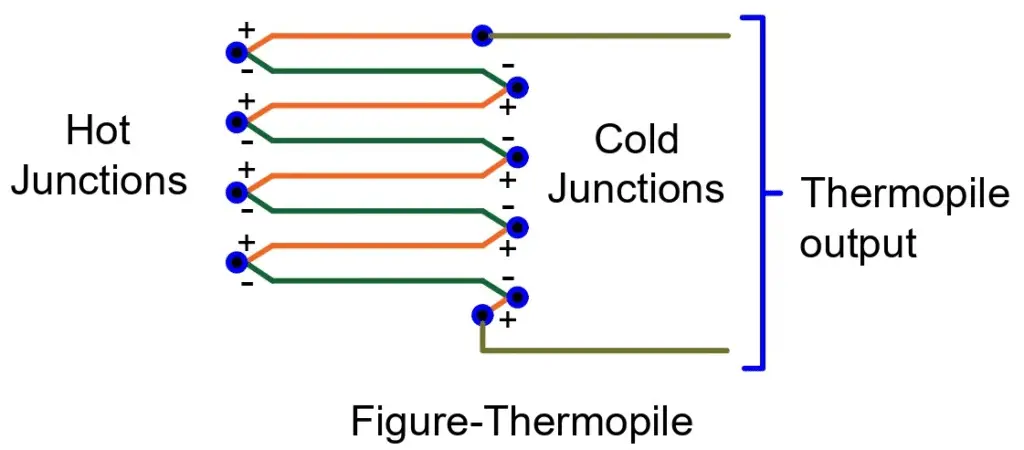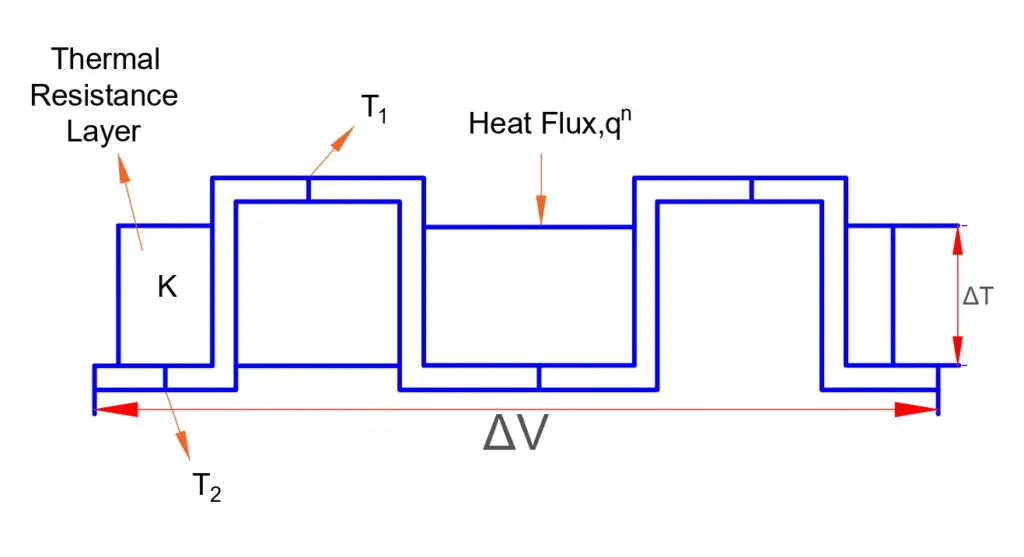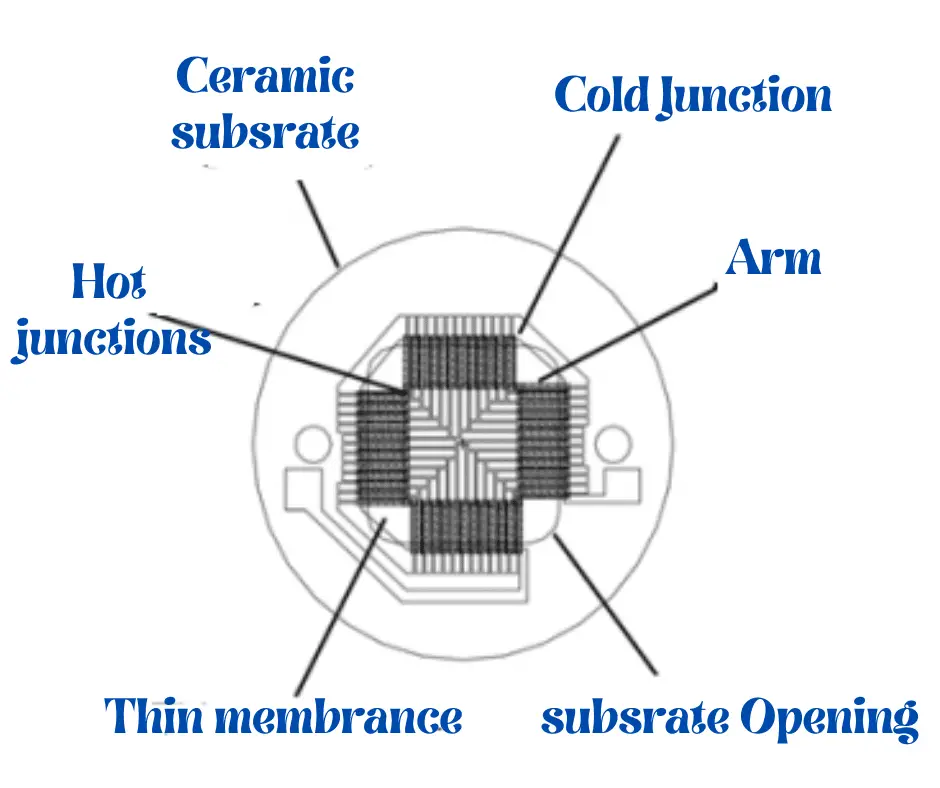A thermopile is a temperature-measuring device that is made up of thermocouples and it converts thermal energy into electrical energy. In this article, we will discuss what is thermopile and its working principle. Before proceeding further, let us discuss what is a thermocouple.
What is a thermocouple?
A thermocouple is a type of temperature sensor that is commonly used in the field of instrumentation & control in many industries. Thermocouple is made up of the junction of two wires of two different metals. When the two junctions made by connecting two metals are exposed to a temperature difference, a small electrical voltage is generated.
The generated voltage is proportional to the temperature difference between the junctions. The generated voltage is very small in terms of millivolts. Thermocouples are the simplest form of temperature measuring devices and their cost is also very low. Hence thermocouples are used widely in many applications.
Now let us move to our main topic.
What is a Thermopile?
A thermopile is a type of temperature measurement device used in the field of instrumentation and control. It is used for measuring high temperatures. It consists of several thermocouples which are connected in the series. The junctions of several thermocouples are connected together to form a single sensing thermopile.
Thermopile Working Principle
The thermocouples are connected in such a manner that all the ‘hot junctions’ voltages add to each other, as well as ‘cold junctions’ voltages. This series configuration of the thermocouples allows the thermopile to generate a larger output voltage as compared to a single thermocouple. Hence, it is suitable for measuring high temperatures.

The output voltage generated by a thermopile is calculated by using the following formula:
V = n * ε * ΔT
where,
V is the output voltage
n is the total number of thermocouples connected in series in the thermopile
ε is the Seebeck coefficient of the metal which is used in the thermocouples
ΔT is the temperature difference that is present across the thermopile.
When the hot junctions of all thermocouples are sensing the temperature of a hot object and the cold junctions of thermocouples are at the same cold junction temperature, then the final output of the thermopile will be four times the potential difference than a single thermocouple.
Thus, it acts as a multiplied thermocouple, generating more voltage compared to the voltage generation of a single thermocouple junction under the same temperature conditions.
Thus, the working principle of thermopile and thermocouple is the same. The thermopile is a series connection of many thermocouples used to measure high temperature.
Thermopile connections
The thermocouples are linked in a chain. The two top thermocouples are at temperature T1, while the two bottom thermocouple junctions are at temperature T2.

The output voltage (ΔV) of the thermopile is directly proportional to the difference in temperature( T1-T2).
Construction of the thermopile
Common metal alloys which are used in the construction of thermopiles are :
- Iron – Constantan
- Chromel – Alumel
- Copper – Constantan.
The choice of selecting metal alloys for the construction of the thermopile totally depends upon the temperature range and accuracy which is required for the application.

The sensing element has small thermocouples on a silicon chip. The sensing element absorbs the thermal energy and produces an output electrical signal. For temperature compensation, one reference sensor is designed into the package. Thermopile infrared (IR) temperature sensors are available with various lens, and filters and it measures non-contact temperature. There are two different types of thermopile detectors.
- Thin Film Based
- Silicon-Based
The Thin Film based thermopiles have antimony (Sb) and bismuth (Bi) as the arm materials. The Silicon based thermopile has alternating n-type and p-type Poly-Silicon or n-type with gold (Au) or aluminum (Al) as its arm materials. Thin Film based thermopile has a lower signal-to-noise ratio as compared to silicon-based.. But, the thin film-based sensor has a slower time constant compared to Silicon Based Thermopile.
Honeywell Thermopile
A Honeywell Thermopile is a non-contact pyrometer. It has ten thermocouple junction pairs arranged in a circle, and its design type is a radiometric non-contact pyrometer.

The hot junctions of all the thermocouples are fixed in the center of this circle- the area where concentrated heat falls and the position of all cold junctions is fixed on the circumference of the circle.
Important Parameters of Thermopile
Accuracy
The accuracy of the thermopile depends on several factors. These factors include :
- The metal alloys used for the construction
- The number of thermocouples used
Generally, the accuracy of the thermopile is in the range of +/- 1 % to +/- 2 % of the full-scale reading.
Temperature Range
The temperature measurement range of a thermopile totally depends on the metals used in the construction of its thermocouples. Some metals are suitable for low-temperature measuring applications, while others are suitable for high-temperature measuring applications. For example, the thermocouple made of iron – constantan is typically used for temperature measurements up to 600°C. On the other hand, the thermocouple made up of chromel – alumel can measure temperatures up to 1200°C.
Cost
Generally, thermopiles are very less expensive than other types of temperature-measuring devices. Other temperatures measuring devices like infrared sensors or resistance temperature detectors (RTD) are much costlier.
Maintenance Procedure of the Thermopile
Regular preventive maintenance of the thermopile is essential to ensure the accuracy of measurement. Regular preventative maintenance includes :
- Cleaning the surface of the thermopile to remove any dirt or debris formed over time.
- Checking the connections and wiring for any signs of damage or corrosion
- Periodic Calibration
Applications of Thermopile
They are widely used in a variety of high-temperature measurement applications like;
- Furnace and kiln temperature measurement
- Combustion and flue gas measurement
- Industrial process control
- Hand-Held Non-Contact Temperature Measurements
- Non-Contact Temperature Measurements in industrial applications and process control
- Tympanic Thermometers
- Used for Infrared Radiometry
- Used for Refrigerant Leak Detection
- Medical Gas Analysis -Anesthetic, incubator CO and CO2, Blood Alcohol Breathalyzers
- Automotive Exhaust Gas Analysis -CO, CO2, & HC
- Commercial building HVAC & lighting control
- Used as Horizon sensors for aircraft, satellites, and hobbyist applications
- Thermal scanner
- HVAC control
- As an occupancy sensor
- Flame and Explosion detection
- Flame and Fire Detection in Aircraft
- Black ice detection and early warning
- Blood Glucose monitoring
- Human Presence and Detection
Advantages of thermopile
The advantages are listed below.
- It is a low-cost device
- Ease of use
- Ability to measure high temperatures.
- They are also durable and rugged which makes them suitable for use in harsh industrial environments.
Disadvantages of thermopile
The disadvantages are listed below.
- They have limited accuracy compared to other types of temperature sensors
- They are sensitive to environmental factors such as wind, which can affect the accuracy of the temperature measurement
- Requires regular maintenance to ensure accurate temperature measurement.